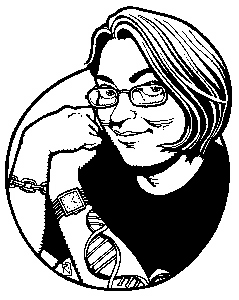![[Metroactive Features]](http://metroactive.com/features/gifs/feat468.gif)
[ Features Index | Silicon Valley | Metroactive Home | Archives ]
Connect the Dots
By Annalee Newitz
FOR YEARS, governments all over the world have secretly been collaborating with the high-end color laser-printer industry in order to track the origin of every color copy made. They're doing it by programming the printers to create specific patterns of yellow dots—not visible to the naked eye—on every copy. These dot patterns are codes for serial numbers, makes of printer and possibly even the time and date made. By cross-checking this information with printer company databases of people who have purchased the printers, federal agents can figure out who made a given color copy and when. No, really.
Xerox has admitted openly that it shares its customer lists with the U.S. Secret Service if asked. And both the U.S. Secret Service and the Dutch government told PC World in a recent article that they had asked printer companies to create the yellow-dot patterns to help law enforcement track down counterfeiting suspects. Because color laser copies are so good, counterfeiters frequently use them to create fake money, as well as fake train tickets and other valuable items.
Right now, the system works because most people don't know about it, and you can only see the yellow dots if you look at the paper under a blue light (to highlight the yellow).
Generally, you need a magnifying glass or a weak microscope, too. It also works because color laser printers are high-end enough that most people buy them using credit cards. That's how the laser-printer companies generate their lists of purchasers associated with specific printer serial numbers.
Robert Lee, a computer-science student, spent his summer after graduating from Yale researching these yellow printer dots, trying to figure out which companies were using them and what they might mean. My co-workers at the Electronic Frontier Foundation helped him along, giving legal and technical pointers along the way.
The result of his two months peering at color laser copies with a blue LED revealed that only one model doesn't use the yellow dots: the Xerox TekTronix Phaser 7700. But most other Xerox models do, as do all the ones he tested by Canon and Toshiba. Because so little is known about what the yellow dots mean (aside from containing make and serial number) and how governments are using them, many disturbing questions arise. For example: How do we know they are only using these printer marks to track counterfeiters? What if they're also tracking people who copy what they think are anonymous political fliers or pamphlets? Or people who post fliers announcing meetings of Muslim groups?
One of the fundamental ways the First Amendment works is by protecting anonymous free speech. These dots undermine your ability to make a color copy anonymously. The government can always track the document back to you. Even if you pay cash for color printouts at Kinko's, your purchase or visit to the store will probably be recorded by a security camera. It appears that the dots may contain a time stamp, so it would be relatively easy to cross-reference a video of a 5:15pm purchase with some copies made at 5:14pm.
How can this happen? Shouldn't there be a law? Yes, there should, but as of now, there are absolutely no regulations or laws that stop printer companies or copy shops from giving information out about their customers to the government. Phone companies and Internet service providers, by contrast, are forbidden to give the government data about you unless served with a court order. But this isn't true for credit-card records kept by laser-printer companies.
Sure, these companies could demand court orders, but none of them have. Xerox told Lee that it has always been happy to comply with the government when it has been asked for this kind of data. But there is something you can do about this, besides writing angry letters to your local Congresscritter.
Seth Schoen of the EFF is continuing Lee's work, gathering as many color copies as he can (see eff.org/Privacy/printers/wp.php). He has received 200 responses so far, from all over the world. He's analyzing the patterns of dots, trying to crack the code to figure out what they say. Most of all, he and Lee want the public to know what they're getting when they print color copies.
Each time you create something on a color laser printer, you're sending a little message to the government: Here's who I am, and here's how to find me.
[ Silicon Valley | Metroactive Home | Archives ]
Copyright © 2005 Metro Publishing Inc. Metroactive is affiliated with the Boulevards Network.
For more information about the San Jose/Silicon Valley area, visit sanjose.com.
![]()

Techsploits
Annalee Newitz ([email protected]) is a surly media nerd who prefers blue dots.
Send a letter to the editor about this story to letters@metronews.com.
From the September 7-13, 2005 issue of Metro, Silicon Valley's Weekly Newspaper.